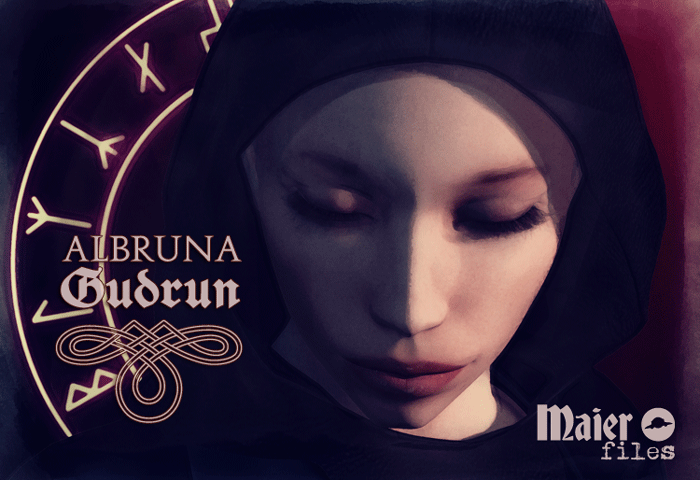In The Maier Files, Albruna Gudrun serves as a muse and spiritual guide, embodying the sacred feminine—a powerful concept that has long been celebrated across various cultures. Her character provides a gateway to understanding a broader tradition of women who have served as keepers of wisdom, bearers of mystical knowledge, and intermediaries between the human and divine realms. By delving deeper into this concept, we can explore how the sacred feminine manifests through figures such as Sappho, Mary Magdalene, Hildegard von Bingen, Teresa of Avila, and the Norse vǫlur—women who have profoundly shaped spiritual and mystical traditions across history.
The Sacred Feminine: A Universal Archetype
The sacred feminine represents the intuitive, emotional, and nurturing aspects of wisdom and spirituality. It is often associated with the Earth and the cycles of nature, symbolizing life, birth, death, and rebirth. The sacred feminine teaches us that knowledge is not solely intellectual but also experiential, rooted in the heart and soul.
Albruna Gudrun, much like the vǫlur and seiðr practitioners of Norse tradition, serves as a bridge between the earthly and the spiritual. She is a seeker of truth, much like the wise women who have been revered throughout history for their unique connection to the divine. In exploring the sacred feminine, it is essential to recognize how it transcends time and geography, weaving its way through various cultures and traditions.

Norse Women of Wisdom: The Vǫlur and Seiðr Practitioners
In Norse tradition, the vǫlur (singular: vǫlva) were powerful sorceresses who practiced seiðr, a form of magic associated with prophecy, healing, and communication with the spirit world. The vǫlur were respected and feared for their ability to access hidden knowledge and manipulate spiritual forces. According to Leszek Gardeła’s work in The Norse Sorceress, the vǫlur’s power stemmed from their connection to both the material and immaterial worlds. They performed rituals that allowed them to see into the past and future, as well as to influence events in the present.
These women, much like Albruna, occupied a liminal space in society, standing between the known and the unknown. The vǫlur’s ability to manipulate reality through ritual and magic made them revered figures, often consulted by rulers and warriors alike. Their rituals were complex, involving songs (varðlokkur), staves, and ceremonial garments, all of which heightened their connection to the spiritual realm. The vǫlva’s prophecies could guide the fate of entire communities, reflecting the sacred feminine’s role as both nurturer and protector.
Mary Magdalene: The Reclaimed Feminine in Christian Mysticism
While the vǫlur operated within a pagan tradition, Mary Magdalene represents the sacred feminine within Christian mysticism. Traditionally misunderstood as a fallen woman, Mary Magdalene has been reinterpreted by scholars and mystics alike as a figure of deep spiritual insight. She was a close companion of Jesus, and many believe that she possessed a unique understanding of his teachings. Some texts, such as the Gospel of Mary, depict her as a leader among the disciples, embodying wisdom and spiritual authority.
Mary Magdalene’s role in Christian mysticism aligns with the sacred feminine’s transformative power. She represents the balance between the physical and spiritual worlds, much like the Norse vǫlur. Both Mary and the vǫlur challenge patriarchal structures, demonstrating that the sacred feminine cannot be confined by traditional gender roles.

Hildegard of Bingen: The Visionary Mystic
Hildegard of Bingen, a 12th-century Benedictine abbess, was another embodiment of the sacred feminine. Known for her visions, Hildegard wrote extensively about theology, medicine, and the natural world. Her works, such as Scivias and The Book of Divine Works, are infused with mystical insights that reflect the interconnectedness of all life—another hallmark of the sacred feminine.
Hildegard’s visions often featured divine femininity, where God was represented as both masculine and feminine. Her understanding of the universe as a harmonious blend of opposites aligns with the sacred feminine’s role in balancing the dualities of life. Like the vǫlur, Hildegard was deeply connected to nature and the cosmos, seeing the divine in all things.
Teresa of Avila: The Mystic of Divine Union
Teresa of Avila, a Spanish mystic and Carmelite nun, is known for her writings on divine union and the spiritual journey. In The Interior Castle, Teresa describes the soul’s ascent toward God, using the metaphor of a castle with many rooms, each representing different stages of spiritual growth. Teresa’s experiences of divine union reflect the sacred feminine’s role in nurturing the soul’s relationship with the divine.
Like the vǫlur and Hildegard, Teresa saw the sacred feminine as a guiding force in her spiritual life. Her teachings emphasize the importance of inner reflection, emotional depth, and spiritual surrender—qualities that are central to the sacred feminine.
Combining Norse Tradition with Other Sacred Feminine Archetypes
The sacred feminine, whether in Norse or Christian traditions, is a force of transformation, intuition, and wisdom. The vǫlur and seiðr practitioners, much like Mary Magdalene, Hildegard, and Teresa, represent the sacred feminine’s ability to access hidden knowledge and provide spiritual guidance.
Leszek Gardeła’s exploration of the Norse sorceress shows that the vǫlur, with their staffs and ceremonial tools, were seen as custodians of spiritual power. In a similar way, Christian mystics like Hildegard used their visions to guide their communities. Both traditions emphasize the sacred feminine’s role in healing, prophecy, and spiritual leadership.
The Timeless Wisdom of the Sacred Feminine
The sacred feminine has been a guiding force across cultures and throughout history. Whether embodied by the Norse vǫlur, Mary Magdalene, Hildegard of Bingen, or Teresa of Avila, the sacred feminine offers a path to deeper understanding, spiritual growth, and the balance between the physical and divine realms. As we explore these different expressions of the sacred feminine, we are reminded of the timeless power of feminine wisdom—a force that transcends time, culture, and religion.



